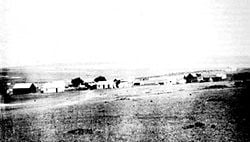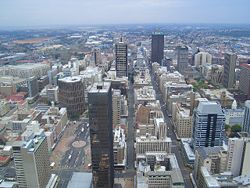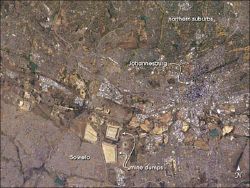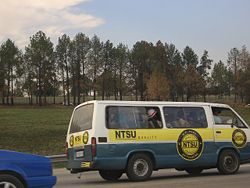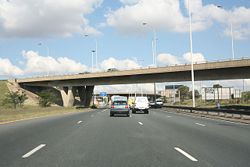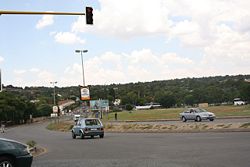Difference between revisions of "Johannesburg" - New World Encyclopedia
Keisuke Noda (talk | contribs) (import from wiki) |
m (Robot: Remove WP Featured template) |
||
| Line 3: | Line 3: | ||
{{about|the city in South Africa}} | {{about|the city in South Africa}} | ||
{{CoorHeader|26|08|00|S|27|54|00|E|type:city}} | {{CoorHeader|26|08|00|S|27|54|00|E|type:city}} | ||
| − | + | ||
<!-- Infobox begins —> | <!-- Infobox begins —> | ||
{{Infobox Settlement | {{Infobox Settlement | ||
Revision as of 02:55, 2 January 2008
- This article is about the city in South Africa. For other uses of the term, see Johannesburg (disambiguation).
| Johannesburg | |
| Johannesburg skyline from Gold Reef City | |
| Motto: Unity in Development | |
| Location of Johannesburg | |
| Coordinates: 26°08′S 27°54′E | |
|---|---|
| Country | South Africa |
| Province | Gauteng |
| Established | 1886 |
| Government | |
| - Mayor | Amos Masondo |
| Area | |
| - Total | 1,644 km² (634.8 sq mi) |
| Elevation | 1,753 m (5,751 ft) |
| Population (2001) | |
| - Total | 3,225,812 |
| - Density | 1,962/km² (5,081.6/sq mi) |
| Time zone | SAST (UTC+2) |
| Area code(s) | 011 |
| Website: www.joburg.org.za | |
Johannesburg, also known as eGoli (place of gold), is the largest and most populous city in South Africa. The city is affectionately known as Jo'burg,Joeys Jozi and JHB by South Africans. Johannesburg is the provincial capital of Gauteng, the wealthiest province in South Africa, and which has the largest economy of any metropolitan region in Sub-Saharan Africa. The city is one of the 40 largest metropolitan areas in the world, and Africa's only officially designated global city (classified as a gamma world city). While often assumed to be South Africa's capital, Johannesburg does not form one of South Africa's three capital cities. Johannesburg does, however, house the South African Constitutional Court - South Africa's highest court.
Johannesburg is the source of a large-scale gold and diamond trade, due to its location on the mineral-rich Witwatersrand range of hills. Johannesburg is also served by O.R. Tambo International Airport, the largest and busiest airport in Africa and a gateway for international air travel to and from the rest of southern Africa.
According to the 2001 Census, the population of the city is more than three million. Johannesburg's land area of 1,644 square kilometres (635 sq mi) is very large when compared to other cities, resulting in a population density of only 1,962 inhabitants per square kilometre (5,082/sq mi). The population of the Greater Johannesburg Metropolitan Area is almost eight million. Johannesburg also encompasses Soweto to the south west, a township that the apartheid government established to accommodate the large number of migrant workers.
History
- Main article: History of Johannesburg
The region surrounding Johannesburg was inhabited by small numbers of Bushmen and the Bantu people. When Europeans arrived in the area, small numbers of Boers and British started farms, but there was no major European settlement until the 1880s, when gold was discovered in the region, triggering a gold rush.
Gold was initially discovered to the east of present-day Johannesburg, in Barberton. Gold prospectors soon discovered that there were even richer gold reefs in the Witwatersrand. Gold was discovered at Langlaagte, Johannesburg in 1886.
Johannesburg was initially a suburb of Pretoria as one had to get permission from the government in Pretoria to build a house in Johannesburg. The town was much the same as any small prospecting settlement, but, as word spread, people flocked to the area from all other regions of the country, as well as from North America, the United Kingdom, and the rest of Europe. As the value of control of the land increased, tensions developed between the Boer government in Pretoria and the British, culminating in the Second Anglo-Boer War. The Boers lost the war and control of the area was ceded to the British. Controversy surrounds the origin of the name, as there were any number of people with the name "Johannes" who were intimately involved in the early history of the place. Two of the prime candidates are the principal clerk attached to the office of the surveyor general, Johannes Rissik, and Christiaan Johannes Joubert, member of the Volksraad and the Republic's chief of mining.
The 1910 declaration of the Union of South Africa paved the way for a more organised mining structure. Later, the South African government instituted a harsh racial system whereby blacks and Indians were heavily taxed, barred from holding skilled jobs, and consequently forced to work as migrant labour on Johannesburg's growing crop of gold mines.
The South African government then instituted a system of forced removals, moving the population of non-European descent into specified areas. It is this system that created the sprawling shantytown of Soweto (South Western Townships), one of the areas where blacks were forced to live during the apartheid era. Nelson Mandela spent many years living in Soweto and his Soweto home in Orlando is currently a major tourist attraction.
Large-scale violence broke out in 1976 when the Soweto Students' Representative Council organized protests against the use of Afrikaans, considered to be the language of the oppressors, as the primary language of instruction in black schools. Police shot into a peaceful student march in Soweto. 1000 people died protesting the apartheid system, in the following 12 months. One of the most famous victims of the massacre, Hector Pieterson, is commemorated with a large Museum dedicated to his memory, in Soweto.
The regulations of apartheid were abandoned in February 1990, and, since the 1994 elections, Johannesburg has been free of discriminatory laws. The black townships have been integrated into the municipal government system, and, to some extent, the suburbs have become multiracial. However, there has been a large-scale migration of businesses and commerce away from the Central Business District and the southern suburbs, in favour of the more affluent northern suburbs. This was fueled by a rise in the crime rate, serious traffic congestion, inadequate public transport, and a more favourable tax environment for landlords in the northern suburbs prior to the integration of the city. Currently the Johannesburg Metropolitan Council is implementing a large scale Inner City Revival project, leading to many business moving back to the inner city.
Government
Template:Johannesburg regions infobox
- Main articles: City of Johannesburg Metropolitan Municipality and Regions of Johannesburg
During the apartheid era, Johannesburg was divided into 11 local authorities, seven of which were white and four black or coloured. The white authorities were 90 % self-sufficient from property tax and other local taxes, and spent Rand 600 (USD93) per person, while the black authorities were only 10% self-sufficient, spending R100 (USD15) per person.
The first post-apartheid City Council was created in 1995. The council adopted the slogan "One City, One Taxpayer" in order to highlight its primary goal of addressing unequal tax revenue distribution. To this end, revenue from wealthy, traditionally white areas would help pay for services needed in poorer, black areas. The City Council was divided into four regions, each with a substantially autonomous local regional authority that was to be overseen by a central metropolitan council. Furthermore, the municipal boundaries were expanded to include wealthy satellite towns like Sandton and Randburg, poorer neighbouring townships such as Soweto and Alexandra, and informal settlements like Orange Farm.
In 1999, Johannesburg appointed a city manager in order to reshape the city's ailing financial situation. The manager, together with the Municipal Council, drew up a blueprint called "Igoli 2002". This was a three-year plan that called upon the government to sell non-core assets, restructure certain utilities, and required that all others become self-sufficient. The plan took the city from near insolvency to an operating surplus of R153 million (USD $23.6 million).
Crime
According to the Johannesburg Victim Survey (1993–1997) The most common crime experienced by the city's residents between 1993 and 1997 was burglary, with nearly a quarter of the respondents (24%) reporting this crime to the survey. The second most frequently reported incidents were violent crimes: mugging and robbery (16,5 per cent) and assault (15,5 per cent). As is the case in many developing countries, the vast majority of assaults were of a serious nature, with 84 per cent involving the use of a weapon [1].
After the Group Areas Act was scrapped in the early 1990s, Johannesburg was affected by urban blight. Thousands of poor, mostly black, people, who had been forbidden to live in the city proper, moved into the city from surrounding black townships like Soweto. Crime levels in formerly white areas rose. Many buildings were abandoned by landlords, especially in high-density areas, such as Hillbrow. Many corporations and institutions, including the stock exchange, moved their headquarters away from the city centre, to suburbs like Sandton. By the late 1990s, Johannesburg was rated as one of the most dangerous cities in the world.
Reviving the city centre is one of the main aims of the municipal government of Johannesburg. Drastic measures have been taken to reduce crime in the city. These measures include closed-circuit television on street corners. Statistics show that crime levels in Johannesburg have dropped as the economy has stabilised and begun to grow [2]. In an effort to prepare Johannesburg for the 2010 FIFA World Cup, local government has enlisted the help of former New York mayor Rudy Giuliani to help bring down the crime rate, as the opening and closing matches of the tournament will be played in the city [3].
Geography and climate
Johannesburg is located in the eastern plateau area of South Africa, known as the Highveld, at an elevation of 1,753 metres (5,751 ft). The city is located on a small ridge called the Witwatersrand (White Water's Ridge: Afrikaans) and the city's northern and western suburbs have undulating hills, while the eastern metro area is generally flat.
The city enjoys a dry, sunny climate, with the exception of occasional late afternoon downpours in the summer months of October to April. Temperatures in Johannesburg are usually fairly mild thanks to the city's high altitude, with the average maximum daytime temperature in January of 26 ℃ (79 ℉), dropping to an average maximum of around 16 ℃ (61 ℉) in June. During the winter, the temperature occasionally drops to below freezing at nightime, causing frost. Snow is a rare occurrence, with snowfall having been experienced in May 1956, September 1981, August 2006 (light). Snow fell again on 27 June 2007, accumulating up to 4 inches in the southern suburbs. The annual average rainfall is 713 millimetres (28.1 in), which is mostly concentrated in the summer months.
Despite the relatively dry climate, Johannesburg has about six million trees, and it is often claimed that the city has the largest man-made (non-commercial) forest in the world. Many trees were originally planted in the northern areas of the city at the end of the 19th century, to provide wood for the mining industry. The areas were developed by the Randlord, Hermann Eckstein, a German immigrant, who called the forest estates Sachsenwald. The name was changed to Saxonwold, now the name of a suburb, during World War I. White residents who moved into the areas, now generally referred to as the Northern Suburbs, retained many of the original trees and planted new ones, with the encouragement of successive city councils. In recent years, however, a considerable number of trees have been felled, to make way for the Northern Suburbs' speedy residential and commercial redevelopment. The city is, therefore, at risk of losing its forest coverage within a few decades.
| Template:Johannesburg weatherbox |
Demographics
According to the 2001 South African National Census, the population of Johannesburg is 3,225,812 people, though including the East Rand and other suburban areas it's around 7 million, consisting of people who live in 1,006,930 formal households, of which 86% have a flush or chemical toilet, and 91% have refuse removed by the municipality at least once a week. 81% of households have access to running water, and 80% use electricity as the main source of energy. 22% of Johannesburg residents stay in informal dwellings. 66% of households are headed by one person.
Black Africans account for 73% of the population, followed by whites at 16%, coloureds at 6% and Asians at 4%. 42% of the population is under the age of 24, while 6% of the population is over 60 years of age. 37% of city residents are unemployed. 91% of the unemployed are black. Women comprise 43% of the working population. 19% of economically active adults work in wholesale and retail sectors, 18% in financial, real estate and business services, 17% in community, social and personal services and 12% are in manufacturing. Only 0.7% work in mining.
34% of Johannesburg residents speak Nguni languages at home, 26% speak Sotho languages, 19% speak English, and 8% speak Afrikaans. 29% of adults have graduated from high school. 14% have higher education (University or Technical school). 7% of residents are completely illiterate. 15% have primary education.
34% use public transportation to commute to work or school. 32% walk to work or school. 34% use private transportation to travel to work or school.
53% belong to mainstream Christian churches, 24% are not affiliated with any organized religion, 14% are members of African Independent Churches, 3% are Muslim, 1% are Jewish and 1% are Hindu.
Economy
Johannesburg is the economic and financial hub of South Africa, producing 16 % of South Africa's gross domestic product, and accounts for 40% of Gauteng's economic activity. Mining is the foundation of the Witwatersrand's economy, but its importance is gradually declining. While gold mining no longer takes place within the city limits, most mining companies have their headquarters in Johannesburg. The city has a great variety of manufacturing industries, including steel and cement plants. Many banking and commercial companies are also located in Johannesburg. Johannesburg has Africa's largest stock exchange, the JSE Securities Exchange. Due to its commercial importance, this city is the site of a number of government branch offices, as well as consular offices and other institutions that are usually found only in capital cities. There is also a very large informal economy consisting of cash-only street traders and vendors which are largely missed in official statistics. The Witwatersrand urban complex is a major consumer of water in a dry region. Its continued economic and population growth has depended on schemes to divert water from other regions of South Africa and from the highlands of Lesotho, but additional sources will be needed early in the 21st century.
The container terminal at City Deep is purported to be the largest "dry port" in the world, with some 60 % of cargo that arrives through the port of Durban arriving in Johannesburg. The City Deep area has been declared an IDZ (industrial development zone) by the Gauteng government, as part of the Blue IQ Project.
Johannesburg's largest shopping centre is Sandton City, while Hyde Park is one of its most prestigious. Other centres include Rosebank, Eastgate, Westgate, Northgate, Southgate, and Cresta. There are also plans to build an extremely large shopping centre, known as the Zonk'Izizwe Shopping Resort, in Midrand. "Zonk'Izizwe" means "All Nations" in Zulu language, indicating that the centre will cater to the city's diverse mix of peoples and races.
Communications and media
Several newspapers and magazines have their offices in the city, as it is the transport and telecommunications centre for the country. Beeld is the leading Afrikaans newspaper for the city and the country, while the City Press is a Sunday newspaper that is the third largest selling newspaper in South Africa. The Sowetan is a major newspaper that is published in Soweto township. The Mail & Guardian is an investigative newspaper while The Citizen is a tabloid-style paper, and The Star is a local newspaper that mostly covers Gauteng-related issues. The Sunday Times is the most widely read Sunday newspaper. True Love is the most widely read women's magazine, catering primarily to the up and coming middle class black female market, published by Media 24.
Johannesburg is also a centre for broadcast media, with such radio stations as YFM, Metro FM, 702, Highveld Stereo, 5FM, Kaya FM and Classic FM situated in the city. Johannesburg is also the headquarters of broadcasters South African Broadcasting Corporation and M-Net, while eTV also has a presence in the city. The city has two television towers, the Hillbrow Tower and the Sentech Tower.
Gospel is the most widely listened to genre of music in South Africa according to AMPS results for 2007.
Suburbs
- Main article: Suburbs of Johannesburg
The different suburbs of Johannesburg are generally categorised by compass direction, as different areas of the city have greatly different personalities. Since Johannesburg is such a large city, there is great variety in the suburbs that comprise it. While the Central Business District and the surrounding areas were formerly highly desired wealthy areas, they have lost their former reputation after migrants took over abandoned buildings, and the crime level rose accordingly. The suburbs to the south of the city are mainly lower-class residential suburbs along with some townships, although most suburbs in the South tend to be extremely large and undistinguished.
The northern and northwestern suburbs have become the centre for the wealthy, containing the high-end retail shops as well as several upper-class residential areas including Houghton, where Nelson Mandela makes his home. The northwestern area in particular is vibrant and lively, with the mostly-black suburb of Sophiatown a hotbed of political activity and the Bohemian-flavoured Melville featuring lively gathering places and nightlife. Auckland Park is home to the headquarters of the South African Broadcasting Corporation and the University of Johannesburg.
To the southwest of the City Centre is Soweto, a mostly black urban area constructed during the apartheid regime specifically for housing African people who were then living in areas designated by the government for white settlement. Today, Soweto is among the poorest parts of Johannesburg. The eastern suburbs include Yeoville, a hot spot for black nightlife despite its otherwise poor reputation, and several residential areas that are slowly gaining respectability.
Tourism
Johannesburg has not traditionally been known as a tourist destination, but the city is a transit point for connecting flights to Cape Town, Durban, and the Kruger National Park. Consequently, most international visitors to South Africa pass through Johannesburg at least once, which has led to the development of more attractions for tourists. Recent additions have centred around history museums, such as the Apartheid Museum and the Hector Pieterson Museum. Gold Reef City, a large amusement park to the south of the Central Business District, is also a large draw for tourists in the city. The Johannesburg Zoo is also one of the largest in South Africa.
The city also has several art museums, such as the Johannesburg Art Gallery, which featured South African and European landscape and figurative paintings. The Museum Africa covers the history of the city of Johannesburg, as well as housing a large collection of rock art. The Market Theatre complex attained notoriety in the 1970s and 1980s by staging anti-apartheid plays, and has now become a centre for modern South African playwriting.
There is also a large industry around visiting former townships, such as Soweto and Alexandra. Most visitors to Soweto go to see the Mandela Museum, which is located in the former home of Nelson Mandela.
The Cradle of Humankind UNESCO World Heritage Site is 25 kilometres to the northwest of the city. The Sterkfontein fossil site is famous for being the world's richest hominid site and produced the first adult Australopithecus africanus and the first near-complete skeleton of an early Australopithecine.
Sports teams and stadiums
Template:Johannesburg sports Johannesburg’s most popular sports by participation are soccer, running, rugby, and cricket. The Lions, formerly the Cats, represent Johannesburg, North West and Mpumalanga in the Southern Hemisphere's Super 14 Rugby Competition, which includes teams from South Africa, Australia, and New Zealand. Johannesburg is also the home of the Golden Lions, who play at Ellis Park Stadium and compete in the Currie Cup.
Early each Sunday morning, tens of thousands of runners gather to take part in informal runs organised by several athletic clubs. People from Johannesburg are football mad and clubs from Johannesburg either play in the Premier Soccer League (PSL) or the First Division. In the PSL, the top Johannesburg teams are all fierce rivals and include Kaizer Chiefs (also known as the Amakhosi), Orlando Pirates (also known as the Buccaneers) and Moroka Swallows, based at the city's Johannesburg, Rand, and FNB stadiums respectively. Witwatersrand University, nicknamed the Clever Boys, who have a player membership of over 1,500, one of the world's largest are also part of the premier league. First Division teams include Katlehong City and Alexander United, who play at Alexander and Reiger Park stadiums respectively
In cricket, the Highveld Lions represent Johannesburg, the rest of Gauteng as well as the North West Province at the Wanderers Stadium. They take part in the Supersport and MTN Domestic Championship. Johannesburg will also be the location of several matches in the 2010 FIFA World Cup, which is to be held in South Africa.
NBA great, Steve Nash was born in Johannesburg as well.
Transport
Johannesburg, much like Los Angeles, is a young and sprawling city geared towards private motorists, and lacks a convenient public transportation system. A significant number of the city's residents are dependent on the city's informal minibus taxis.
Mass transit
Johannesburg's metro railway system connects central Johannesburg to Soweto, Pretoria, and most of the satellite towns along the Witwatersrand. The railways transport huge numbers of workers every day. However, the railway infrastructure was built in Johannesburg's infancy and covers only the older areas in the city's south. In the past half century Johannesburg has grown largely northwards, and none of the northern areas, including the key business districts of Sandton, Midrand, Randburg, and Rosebank, have any rail infrastructure.
The Gauteng Provincial Government's Blue IQ Project, Gautrain, however, has made provisions for the creation of a rapid rail link, running north to south, between Johannesburg and Pretoria, and east-west between Sandton and Johannesburg International Airport. Slated to be ready in time for the 2010 FIFA World Cup, the rail system is being designed to alleviate traffic on the N1 freeway between Johannesburg and Pretoria, which records vehicle loads of up to 160,000 per day.
Airports
Johannesburg is served by OR Tambo International Airport (formerly Johannesburg International Airport) for both domestic and international flights. Other airports include Rand Airport, Grand Central Airport, and Lanseria. Rand Airport, located in Germiston, is a small airfield used mostly for private aircraft and the home of South African Airways's first Boeing 747 Classic, the Lebombo, which is now an aviation museum. Grand Central is located in Midrand and also caters to small, private aircraft. Lanseria Airport is used for commercial flights to Cape Town, Botswana, and Sun City.
Buses
Johannesburg is served by a bus fleet operated by Metrobus, a corporate unit of the City of Johannesburg. It has a fleet consisting of approximately 550 single and double-decker buses, plying 84 different routes in the city. This total includes 200 modern buses (150 double-deckers and 50 single-deckers), made by Volvo and Marcopolo/Brasa in 2002. Metrobus' fleet carries approximately 20 million passengers per annum. Metrobus also operates a number of open-top buses in the "City Slicker" role, using them to provide guided tours around the city. In addition there are a number of private bus operators, though most focus on the inter-city routes, or on bus charters for touring groups.
Taxis
Johannesburg has two kinds of taxis, metered taxis and minibus taxis. Unlike many cities, metered taxis are not allowed to drive around the city looking for passengers and instead must be called and ordered to a destination. Metered taxis are rare, in comparison to many other cities.
The minibus "taxis" are the de facto standard and essential form of transport for the majority of the population. Since the 1980s The minibus taxi industry has been severely affected by turf wars.
Although essential, these taxis are often of a poor standard in not only road-worthiness, but also in terms of driver quality with a majority of taxi drivers breaking traffic laws regularly (such as driving in the emergency lane while speeding on a highway). With the high demand for transport by the working class of South Africa, minibus taxis are often over-filled with passengers causing yet another hazard for road users. However, without subsidies from Government and a lack of other feasible public transport, minibus taxis will remain an essential form of transport for many of Joburg's working class.
Freeways
- Main article: Johannesburg freeways
The fact that Johannesburg is not built near a large navigable body of water has meant that from the very beginning of the city's history, ground transportation has been the most important method of transporting people and goods in and out of the city. One of Africa's most famous "beltways" or ring roads/orbitals is the Johannesburg Ring Road. The road is comprised of three freeways that converge on the city, forming an 80-kilometre loop around it: the N3 Eastern Bypass, which links Johannesburg with Durban; the N1 Western Bypass, which links Johannesburg with Pretoria and Cape Town; and the N12 Southern Bypass, which links Johannesburg with Witbank and Kimberley. The N3 was built exclusively with asphalt, while the N12 and N1 sections were made with concrete, hence the nickname given to the N1 Western Bypass, "The Concrete Highway". In spite of being up to 12 lanes wide in some areas (6 lanes in either direction), the Johannesburg Ring Road is frequently clogged with traffic. The Gillooly's Interchange, built on an old farm and the point at which the N3 Eastern Bypass and the R24 Airport Freeway intersect, is purported to be the busiest interchange in the Southern Hemisphere. It is also claimed that the N1 is the busiest road in South Africa.
Trains
Construction of the Gautrain Rapid Rail started in October 2006 and will be completed by 2010, in time for the FIFA World Cup. It will comprise of a number of underground stations, as well as above ground stations. It will run from Johannesburg's Park Station, through Rosebank, Sandton, Midrand and into Pretoria. There will also be a line from the OR Tambo International Airport traveling to Sandton. This will be the first new railway system that has been laid in South Africa since 1977.
Universities in Johannesburg
Johannesburg has a well-developed higher education system of both private and public universities. Johannesburg is served by the public universities University of the Witwatersrand and the University of Johannesburg.
University of Johannesburg was formed on 1 January 2005 when three separate universities and campuses—Rand Afrikaans University, Technikon Witwatersrand, and the Johannesburg campuses of Vista University—were merged. The new university offers education primarily in English and Afrikaans, although courses may be taken in any of South Africa's official languages.
The University of the Witwatersrand is one of the leading universities in South Africa, and is famous as a centre of resistance to apartheid, earning it the nickname "Moscow on the Hill".
Private universities include Monash University, which has one of its eight campuses in Johannesburg (six of the other campuses are in Australia, while the eighth is in Malaysia), and Midrand Graduate Institute which is located in Midrand.
Sister cities
Johannesburg's sister cities are:
 Birmingham, England (United Kingdom)
Birmingham, England (United Kingdom) New York City, New York (United States)
New York City, New York (United States) Xi'an, China.
Xi'an, China. São Paulo, Brazil.
São Paulo, Brazil.
ReferencesISBN links support NWE through referral fees
- Early Johannesburg, Its Buildings and People. Hannes Meiring, Human & Rousseau. 1986. 143 pages. ISBN 0-7981-1456-8
- Gold! Gold! Gold! The Johannesburg Gold Rush. Eric Rosenthal, AD. Donker, 1970, ISBN 0-949937-64-9
- Johannesburg: The Elusive Metropolis. Sarah Nuttall. Duke University Press. 9 January 2005. 210 pages. ISBN 0-8223-6610-X.
- The Corner House: The Early History of Johannesburg. Alan Patrick Cartwright. MacDonald. 1965. 293 pages.
See also
- Large Cities Climate Leadership Group
External links
Government
News
Other
- Travel guide to Johannesburg from Wikitravel
- Johannesburg on Google Maps
- Johannesburg on Birmingham's Partner City page
- Economist.com City Guide
- Current Happenings and Tourist Info
Template:Johannesburg Template:Gauteng province Template:South Africa Provincial Capitals
af:Johannesburg ar:جوهانسبرغ frp:J·ohanesbôrg bg:Йоханесбург ca:Johannesburg cs:Johannesburg da:Johannesburg de:Johannesburg et:Johannesburg el:Γιοχάνεσμπουργκ es:Johannesburgo eo:Johanesburgo fa:ژوهانسبورگ fr:Johannesburg gd:Johannesburg gl:Johannesburgo ko:요하네스버그 id:Johannesburg zu:IGoli is:Jóhannesarborg it:Johannesburg he:יוהנסבורג sw:Johannesburg lt:Johanesburgas hu:Johannesburg mk:Јоханесбург nl:Johannesburg ja:ヨハネスブルグ no:Johannesburg nn:Johannesburg nov:Johannesburg pl:Johannesburg pt:Joanesburgo ro:Johannesburg ru:Йоханнесбург simple:Johannesburg sk:Johannesburg sl:Johannesburg sr:Јоханесбург sh:Johannesburg fi:Johannesburg sv:Johannesburg vi:Johannesburg ve:Johannesburg tr:Johannesburg vo:Johannesburg zh:约翰内斯堡
Credits
New World Encyclopedia writers and editors rewrote and completed the Wikipedia article in accordance with New World Encyclopedia standards. This article abides by terms of the Creative Commons CC-by-sa 3.0 License (CC-by-sa), which may be used and disseminated with proper attribution. Credit is due under the terms of this license that can reference both the New World Encyclopedia contributors and the selfless volunteer contributors of the Wikimedia Foundation. To cite this article click here for a list of acceptable citing formats.The history of earlier contributions by wikipedians is accessible to researchers here:
The history of this article since it was imported to New World Encyclopedia:
Note: Some restrictions may apply to use of individual images which are separately licensed.
